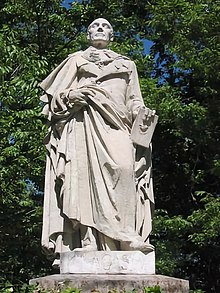This article needs additional citations for verification. (December 2009) |
Mariano Lagasca y Segura (1776–1839), also known as Mariano la Gasca, was a Spanish botanist, writer and doctor. He was the director of the Real Jardín Botánico de Madrid (Royal Botanical Garden of Madrid).
Mariano Lagasca y Segura (Mariano la Gasca) | |
|---|---|
 Statue by Ponciano Ponzano in the Royal Botanical Garden of Madrid | |
| Born | 4 October 1776 |
| Died | 23 June 1839 (aged 62) |
| Nationality | Spanish |
| Occupation(s) | botanist, doctor, writer |
| Known for | improvement of the Real Jardín Botánico de Madrid (Royal Botanical Garden of Madrid) |
Early life
editMariano Lagasca y Segura was born in Encinacorba, Province of Zaragoza, in Spain on 4 October 1776 to a wealthy Catholic family. He studied at the local elementary school and, afterwards, he continued his ecclesiastical studies in Tarragona. During his studies in Tarragona, he developed an interest for medicine and botany. After finishing his studies in Tarragona, he started travelling until eventually studying medicine at first in Zaragoza, and later in Valencia and Madrid.[1]
Career
editIn 1800, he moved to Madrid where he met Antonio José Cavanilles, a well-known botanist and doctor and became his disciple. In Madrid, he cooperated in various fields José Demetrio Rodriguez, and co-published with him a botanical book titled Description of certain plants of the Royal Botanical Garden of Madrid (Spanish: Descripción de algunas plantas del Real Jardín Botánico de Madrid) in 1801.[1]
In 1802, he co-published with Simón de Rojas Clemente y Rubio a volume of articles regarding medicine and botany. After the death of José Cavanilles in 1807, he was appointed to the position of the vice-director of the Royal Botanical Garden of Madrid. During that period, he was also working as a professor of Botany at the university of Madrid.[1]
In 1815, after the Peninsular War, he was appointed to the position of the director of the Royal Botanical Garden of Madrid.
In 1816, he published Genera et species plantarum, quae aut novae sunt aut nondum recte cognoscuntur, which contained 364 names of plants.[2]
In the following years, he would become well known in Spain, because of his work at that position. In 1823, he was exiled from Spain because of his liberal political views. He spent the following eleven years in London, until his return to Spain in 1834 where he regained his position as a director of the Royal Botanical Garden of Madrid. He died five years later, on 23 June 1839, in Barcelona.[1]
In 1827, he edited and printed his herbarium work Hortus siccus Londinensis; or a collection of dried specimens of plants, growing wild within twenty miles round London, named on the authority of the Banksian herbarium, and other original collections which might be an exsiccata-like series with duplicate specimens.[3]
See also
editReferences
edit- ^ a b c d Colmeiro, Miguel, "La botánica y los botánicos de la Península Hispano-Lusitana : estudios bibliográficos y biográficos", Madrid, imprenta y Estereotípa de M. Rivadeneyra, 1858 Rivadeneyra
- ^ "Genera et species plantarum, quae aut novae sunt aut nondum recte cognoscuntur | International Plant Names Index". www.ipni.org. Retrieved 13 October 2021.
- ^ "Hortus siccus Londinensis; or a collection of dried specimens of plants, growing wild within twenty miles round London, named on the authority of the Banksian herbarium, and other original collections: IndExs ExsiccataID=880107904". IndExs – Index of Exsiccatae. Botanische Staatssammlung München. Retrieved 12 August 2024.